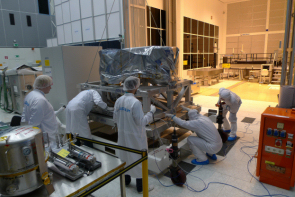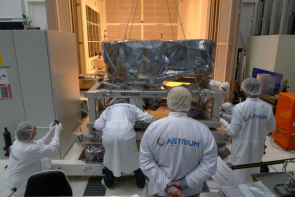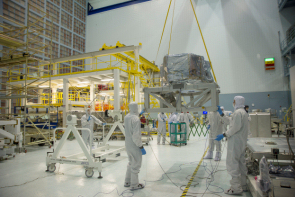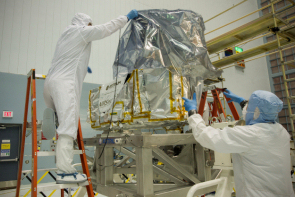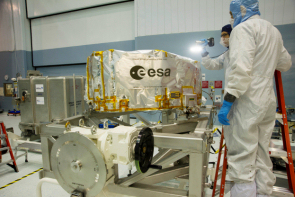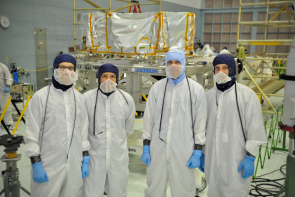#03: NIRSpec arrives at NASA Goddard
30 September 2013
The Near-Infrared Spectrograph (NIRSpec), contributed by ESA to the James Webb Space Telescope (JWST), has arrived at NASA's Goddard Space Flight Center. The instrument - which will study astronomical objects ranging from some of most distant galaxies, to our Solar System, or planets orbiting around other stars in our own Galaxy - landed at Baltimore Washington International airport on 20 September and was transported by truck to NASA Goddard.NIRSpec underwent vigorous testing in Europe before being delivered to ESA by prime contractor Astrium GmbH in Ottobrunn, Germany. As detailed in the previous journal entry, the campaign included acoustic and vibration testing, to simulate the launch conditions aboard Ariane 5. A last, short, cryogenic test was successfully completed at the end of summer. After some final alignment checks and inspections, the instrument was officially handed over to ESA and declared fit for shipment to NASA in September.
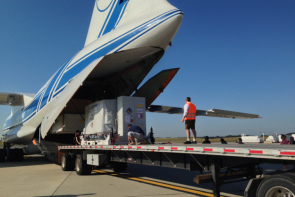 |
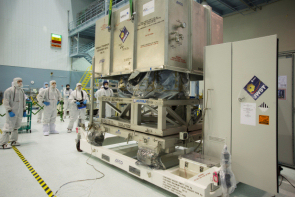 |
| NIRSpec is offloaded at Baltimore Washington International airport. Credit: NASA/Chris Gunn | NIRSpec arrives at Goddard Space Flight Center. Credit: NASA/Chris Gunn |
NIRSpec was then prepared for its journey to the Goddard Space Flight Center, where NASA is assembling JWST. There, each instrument is added to the payload module, known as the Integrated Science Instrument Module (ISIM). The Mid-Infrared Instrument (MIRI), delivered to NASA in May 2012, and the Fine Guidance System/Near-InfraRed Imager and Slitless Spectrograph (FGS/NIRISS) have already been installed on ISIM and are currently undergoing the first cryogenic tests.
Like any transatlantic air shipment, NIRSpec had to be packed carefully with full customs papers. The instrument's 'cocoon' for travelling to the other side of the ocean was designed to protect it from shocks, vibration, and excessive humidity. The shipment also carried the ground support equipment needed for handling and testing NIRSpec at its destination. The cargo was loaded on board an IL-76 at Munich Airport on 19 September and flown to Baltimore Washington International airport in Maryland.
The plane landed early on the morning of 20 September. NIRSpec was offloaded with care and taken to Goddard Space Flight Center, where the JWST is gradually taking shape in the Space Systems Development and Integration Facility (SSDIF) - the largest 'class 10 000' cleanroom facility in the world. Over the next few weeks a series of incoming inspections, functional tests and alignment checks will be performed in this SSDIF cleanroom facility. The instrument will then be prepared for integration to the ISIM in the beginning of next year.
Watch the assembly of the James Webb Space Telescope on NASA Goddard's 'Webb' cam [the ISIM was taken out of the cleanroom, for cryogenic tests, in the third week of September].
About JWST
The James Webb Space Telescope (JWST) will be a general-purpose observatory with a 6.5-m telescope optimised for infrared observations and a suite of 4 astronomical instruments capable of addressing many of the outstanding issues in astronomy. The primary aim is to examine the first light in the Universe - those objects which formed shortly after the Big Bang. Further aims include: looking at how galaxies form; the birth of stars; and the search for protoplanetary systems and the origin of life, including the study of exoplanets. JWST is a joint project of NASA, ESA and the Canadian Space Agency. It is scheduled for launch in 2018 by an Ariane 5 and will operate approximately 1.5 million kilometres from the Earth in an orbit around the second Lagrange point of the Sun-Earth system, L2.
About NIRSpec
The Near InfraRed Spectrograph (NIRSpec) is one of four instruments on JWST. NIRSpec is a multi-object spectrograph capable of observing more than 100 astronomical objects simultaneously. It will support JWST's four main science themes by providing low, medium and high-resolution spectroscopic observations.
NIRSpec is built by European industry to ESA's specifications and managed by the ESA JWST Project at ESTEC, the Netherlands. The prime contractor is EADS Astrium GmbH in Ottobrunn, Germany. The NIRSpec detector and MSA subsystems are provided by NASA's Goddard Space Flight Center.

